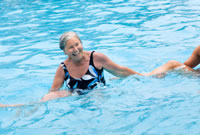The Benefits of Physical Fitness in Lower Back Pain
Many of the benefits of physical fitness will also affect your lower back although how these improvements can help lower back pain may not be so obvious to you.
 Improving your physical fitness is a key component in the management of lower back pain and recent studies support the view that getting fitter and exercise for back pain can be helpful.
Improving your physical fitness is a key component in the management of lower back pain and recent studies support the view that getting fitter and exercise for back pain can be helpful.
When I talk to people about the benefits of physical fitness and getting a bit fitter (which I do very often!), I often find that most people see fitness as about improving your heart and lung function and they can't always see what that has to do with their back pain. However, it also has a real impact on lots of other things and the following section outlines the real benefits of physical fitness in managing lower back pain.
The Heart
Exercise helps your heart become a stronger and more efficient pump. Your heart becomes stronger which means that with each heart beat more blood is circulated and so the heart does not need to work so hard and your pulse rate reduces. This links closely with the next point.
The Circulation
One of the major benefits of physical fitness is that regular physical activity increases the number and size of the blood vessels in your body which improves the blood supply to all the tissues in the body. This improves the health of your muscles which of course includes your spinal and core muscles.
As an aside you may not realise that smokers are at a greater risk of developing back pain then non-smokers. I was surprised about this until I read about it. Smoking reduces the blood supply to your tissues (which is why smokers often lose legs to amputation) and will cause a reduction in the health of the tissues in your back as well.
Lung Function
This improves with exercise, the lungs become stronger and breathing muscles get fitter which means the lungs can expand more. This improves the amount of oxygen available to the body and can improve the health of the tissues in your back too.
Muscles
As a result of regular exercise muscle cells become better able to release energy. The muscles have improved strength and muscular endurance. You need strong supportive muscles for a healthy spine.
Weight
Exercise can help in the control of weight. Combining a calorie controlled diet with exercise is universally accepted as the way to manage weight problems. There is some evidence of a link between being very overweight and lower back pain.
Ligaments and Joints
These tissues become stronger, more flexible and less prone to injury. Increased blood supply means better nutrition for the tissues and better removal of waste products which helps improve the health and durability.
Bones
Weight bearing exercise is shown to increase bone density and also prevent bone loss as we get older. This can reduce the onset and severity of osteoporosis (this is thinning of the bones, osteoporosis can lead to fractures of the spinal vertebrae)
Protection from Cardiovascular Disease.
Exercise reduces the chance that you will develop high blood pressure, it reduces cholesterol levels, it also improves the bodies ability to respond to insulin which in turn helps reduce weight and blood pressure.
Stress
Another of the benefits of physical fitness is the impact exercise has on stress. Exercise encourages the release of endorphins which increase your sense of well being and can be helpful in reducing pain. There is good evidence that worry and fear of exercise can make the outcome from lower back pain worse.
So you can see there are many benefits of physical fitness which may have a positive effect on your lower back pain.
Before starting any physical fitness programme please go and see your doctor and get checked out first.
What is Physical Fitness?
What is physical fitness? It is actually a combination of several aspects rather than one single thing.
"Health is a state of complete physical, mental and social well-being, and not merely the absence of disease or infirmity." ~World Health Organization, 1948
 Complete physical fitness includes both health related and skill related ingredients:
Complete physical fitness includes both health related and skill related ingredients:
Health Related Physical Fitness
- Balanced body composition – in other words the ratio of fat to muscle i.e. greater lean body mass and reduced body fat.
- Cardiovascular fitness – stronger heart, reduced heart rate, reduced blood pressure, better exchange of oxygen in the tissues, improved circulation.
- Flexibility – improved performance and possibly protection from joint and muscle problems.
- Muscular endurance and strength – much the same as for flexibility, muscular fitness means you are better able to perform work and leisure activities and there may be better protection from injury.
Skill related components of physical fitness:
These skill related aspects are all things that you can train to improve. Exercise classes like pilates and yoga help with balance and co-ordination. Many other sports that need skilled co-ordination such as football, basketball or tennis will all help with these specific aspects of fitness.
- Agility
- Balance
- Coordination
- Power
- Reaction Time
- Speed
Together these make up the basic physical fitness components.
So what is physical fitness? It is a combination of all these things. It is perfectly possible to have one aspect of physical fitness and not others. For example a weight lifter may have great strength and a high lean body mass but may not have good cardiovascular fitness.
If you have lower back pain, improving your fitness levels may help you manage your problem more effectively.
5 Components of Physical Fitness
Many text books talk about the 5 components of physical fitness; these are the health related fitness components. If you are looking to manage your lower back pain by improving your physical fitness l evels then they are a good place to start. There are in fact other components of physical fitness but they are skill related and in my opinion less important in the management of lower back pain.
evels then they are a good place to start. There are in fact other components of physical fitness but they are skill related and in my opinion less important in the management of lower back pain.
- Fitness for your heart and lungs (cardiovascular fitness).
Improved cardiovascular fitness with a slower heart rate. It also means a greater lung capacity and an improvement in the exchange of oxygen in the tissues. Circulation is improved, in all the tissues of the body, including ligaments and muscles. - Flexibility – the ability to move and bend your body.
I have talked about the importance of having a strong flexible spine and have suggested some exercises for stretching here. - Strength – Strong, supple muscles
Strong muscles get tired less easily, are better able to perform tasks whether that is supporting your spine for long periods when sitting or when you are doing more energetic activities like gardening or manual work. See some core stability exercises here.
- Endurance – The ability to keep going.
If your muscles tire after a short while they are not able to give you the support you need so you are more vulnerable to injury.
- Fatness – having greater lean, or muscle, body mass.
This is important as the more you exercise the greater the chance that your body composition will change and you will have more muscle and less fat. This is a bit controversial with lower back pain as many doctors often blame weight for back pain problems when there are often many reasons for it. However, there is some evidence that being very overweight contributes to lower back pain.
Lower Back Pain Toolkit Home Page
References
Andersen, R., Crespo, C., Bartlett, S., Bathon, J., & Fontaine, K. 2003, "Relationship between body weight gain and significant knee, hip, and back pain in older Americans", Obesity research, vol. 11, no. 10, pp. 1159-1162
.
Bener, A., Alwash, R., Gaber, T., & Lovasz, G. 2003, "Obesity and low back pain", Collegium antropologicum, vol. 27, no. 1, pp. 95-104.
Lee, C., Kratter, R., Duvoisin, N., Taskin, A., & Schilling, J. 2005, "Cross-sectional view of factors associated with back pain", International archives of occupational and environmental health, vol. 78, no. 4, pp. 319-324.
Corbin & Lindsey 1985, Concepts of Physical Fitness Brown, Iowa.
Chou, R. & Huffman, L. H. 2007, "Nonpharmacological view of the Evidence for an American Pain Society/American College of Physicians Clinical Practice Guideline", Annals of Internal Medicine, vol. 147, no. 7, pp. 492-504.
02-Mar-2015